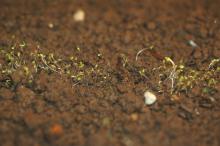Cause Both Pythium spp. a fungus-like microorganism and Rhizoctonia solani, a fungus, can cause pre- and post-emergence damping-off. Pythium irregulare, the species found frequently in the Northeastern United States, is favored by cool and overly moist soil conditions. Pythium spp. can survive in dust, planting media, or soil particles on greenhouse floors, flats, and pots. Spread can also occur via movement of infected plants. Seedlings are susceptible during the first two weeks of germination but rapidly become resistant as the first new leaves are formed. The organism can enter roots damaged by high soluble salts from overfertilization.
Rhizoctonia survives in soil as sclerotia or as mycelium colonizing bits of organic matter. Roots become infected as they grow past these structures. The fungus then grows along root surface and forms an aggregation called an infection cushion, then pushes into the root where it colonies and kills the tissue. The fungus can form knots of mycelium that develop into sclerotia. These are released into the soil as the plant debris decomposes. The fungus can be spread by water, contaminated tools, transportation of infected plants, and propagation of infected plants. Disease is favored by high temperatures and moderately moist soils.
High substrate pH may cause stunted or uneven seedling growth or poor root development, which may be confused with damping-off. Very high pH may result in iron or boron deficiency. Yellow interveinal chlorosis of upper leaves may be caused by iron deficiency resulting from high pH or a cool, wet medium, which reduces iron uptake.
Symptoms Stems of seedlings or recent transplants collapse at the soil line and die. Pythium turns root tips brown; they then decay. Basal stem tissues below the soil line may also rot. Plants often remain stunted, chlorotic and wilt. Rhizoctonia forms red-brown lesions near the soil line. Wilting, collapse and death occur if lesions girdle the stem. It is not easy to tell these organisms apart by visual inspection so send to your Plant Clinic for a diagnosis.
Cultural control
- Plant in pasteurized, well-drained raised beds.
- Rotate to different beds from year to year.
- For greenhouse production, start seeds in a sterile media of pH 5.5 to 5.8 and at a temperature of 65°F to 75°F.
- Do not overfertilize.
- Many cultivars need light for germination so germinate with little or no media covering seeds.
- Keep media evenly moist but not overly wet.
- Avoid reusing pots or trays from a previous crop for propagation. If pots or trays must be reused then wash off all debris and soak in a sanitizing solution or treat with aerated steam for 30 min.
Chemical control for Pythium-Use only with cultural controls and rotate among fungicides with different modes of action. Isolates resistant to Group 4 fungicides have been found in the Northeastern United States. Efficacy of fungicides may be species dependent.
- Banol at 2 to 3 fl oz/10 gal water. Group 28 fungicide. 12-hr reentry.
- Fenstop at 7 to 14 fl oz/50 to 100 gal water. Use 1 to 2 pints/sq ft. For greenhouse use only. Group 11 fungicide. 12-hr reentry.
- Fosphite at 1 to 2 quarts/100 gal water. Do not use copper products within 20 days of treatment and do not use spray adjuvants. Group P7 fungicide. 4-hr reentry.
- Mefenoxam 2 AQ at 0.12 to 0.24 fl oz/100 gal water as a soil drench at seeding. Group 4 fungicide. No restrictions on reentry when used as a soil drench or media incorporation.
- Monterey Garden Phos at 1 teaspoons/8 gal water as a soil drench. Group P7 fungicide. H
- Proplant at 2 to 3 fl oz/10 gal water. Group 28 fungicide. 12-hr reentry.
- Segway O at 1.5 to 3 fl oz/100 gal water. Drench rate is based on pot diameter. Group 21 fungicide. 12-hr reentry.
- Subdue MAXX at 0.13 to 0.25 fl oz/100 gal water as a seeding drench. Group 4 fungicide. No restrictions on reentry when used as a soil drench.
- Terrazole 35 WP at 3.5 to 10 oz/100 gal water as a soil drench. Group 14 fungicide. 12-hr reentry.
Chemical control for Rhizoctonia
- Broadform at 2 to 8 fl oz/100 gal water. Group 7 + 11 fungicide. 12-hr reentry.
- Chipco 26019 FLO at 13 fl oz/100 gal water. Use 1 to 2 pints/sq ft of this solution. Group 2 fungicide. 12-hr reentry.
- Empress at 1 to 3 fl oz/100 gal water can be used for seedlings. Group 11 fungicide. 12-hr reentry.
- Medallion WDG at 1 to 2 oz/100 gal water. Using with oils or adjuvants may damage plant. Group 12 fungicide. 12-hr reentry.
- Spirato GHN at 1 fl oz/100 gal water. Use with oils or adjuvants may cause plant damage. Group 12 fungicide. 12-hr reentry.
- Terraclor 400 at 6 to 12 fl oz/100 gal water. Application rate of this solution is based on pot diameter and/or depth of soil, see label for details. Group 14 fungicide. 12-hr reentry.
References Mellano, H.M., Munnecke, D.E. and Endo, R.M. 1970. Relationship of seedling age to development of Pythium ultimum on roots of Antirrhinum majus. Phytopathology 60:935-942.
Wegulo, S.N., and Chase, A.R. 2018. Diseases of Snapdragon. In McGovern, R.J. and Elmer, W.H. (eds.) Handbook of Florists' Crops Diseases. Springer Int.


